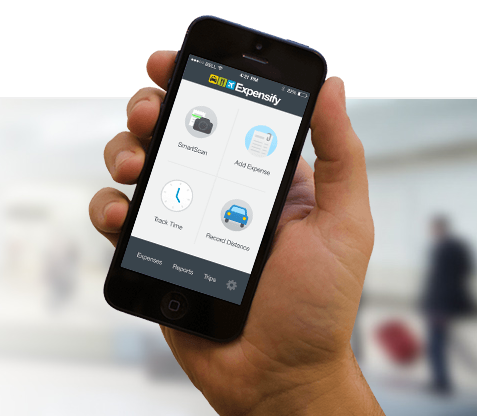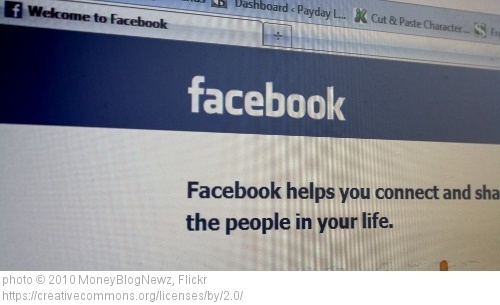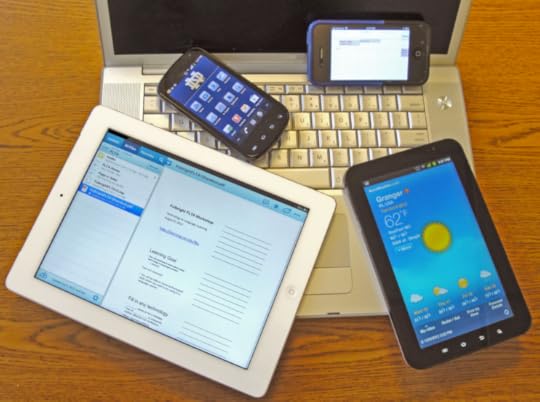Randi Zuckerberg's Blog, page 46
June 4, 2014
I’m Teaching My Mom A Computer Class And I’m Learning More Than She Is!
To help my Mom combat her electronic anxieties, I volunteered to teach her computer classes. I knew when I raised the idea it would be a big commitment because in order to truly succeed in this pursuit, I would be forced to challenge some of my core Gen Y character traits (or flaws, depending on which generation you’re from).
You see, Mom’s a Baby Boomer and I’m a proud member of Gen Y – also known as a millennial. That means I have a short attention span, I get easily frustrated, and I always multi-task.
When we kicked off our first class, I used all my will power to put my digital distractions aside and pay attention. I logged off from Facebook, signed out of Twitter, turned my phone on silent and vowed to not open Instagram for at least 30 minutes. Yep, huge commitment.
To give a little tech background, my Mom uses an iPhone 4 for calls (I keep telling her to upgrade), SMS and WhatsApp. She has boosted the font size on her iPhone to the largest possible – no judgement – and she types way slower than I do on her iPhone and laptop. Peck, tap, peck. That kind of thing.
The goal of our first session was simple – to find out what Mom doesn’t know in order to determine what she needs to know. And here’s the list: Mom doesn’t know how to start new paragraphs in emails, she can’t transition between different windows if a few are open at the same time, and my favorite, which I can only express via her direct quote: “If I do something with the mouse on the side, all of a sudden I’m in 2010. I slowly move my arrow up, and then spend two hours getting back to today.” To translate, this means if Mom is in her inbox, and accidentally moves the vertical scroll bar down, she doesn’t know how to scroll back up. Instead, she clicks from email to email to return to the most recent.
Here’s the thing I find amazing though; despite only managing basic computer navigation, Mom excels in online purchases. She’s like the Jackie Chan of online shopping; analyze, strike, takedown. If her credit card is handy, no brand or item is ever out of reach. When you see her wild purchases you wouldn’t think they’re made by the same person who is scared to click the right-hand button on her mouse. But I guess it’s like anything in life – if you want something bad enough, you’ll always find a way, right?
Anyway, it was obvious I have a lot to teach her. What I wasn’t expecting, though, was how much I’d learn in the process. For the first time I saw the internet and tech world through the eyes of a Baby Boomer who isn’t well-versed in all things digital – and quite honestly, it’s frightening. I realized just how different our relationship is with technology. It’s so, so different.
Firstly, I’m a self-confessed iPhone and social media addict. I go out on dates but truthfully, I feel like I’m in a pretty committed relationship with my iPhone. The best part is that every 18 months I get an upgrade. Have you ever met a guy that gets slimmer, with better features, a year and a half into your relationship? I doubt it.
Second, I immerse myself in as much tech-related news as possible; the latest iWatch rumours, Facebook’s algorithm changes and Kimye’s record-breaking Instagram pic. I can’t get enough.
And also, the daily tech questions that Mom and I grapple with are completely different. I ask ‘Have I read the latest articles on Mashable? Are these new OS X Mavericks updates making my computer slower? And should I post this photo of me twerking on Instagram or Twitter?’ In contrast, Mom asks about cursors, punctuation and navigation bars.
After becoming aware of these huge gaps in her computer skills, I’ve realized it’s my duty to put aside my digital distractions and continue teaching her computer classes. Considering how much she’s given up for me in her lifetime, it’s not a big ask at all. In fact, it’s the perfect way to say thanks. Just imagine how much more shopping she can do when she learns how to browse-and-buy with multiple windows open.
Posted On: 6/4/14
 Jordana Borensztajn is a comedian, corporate speaker and social media trainer. She drinks a lot of coffee, loves hanging out in Apple stores, and is currently spending way too much time on Instagram. Tweet her any time at @JordanaOZ or hit her up on Facebook. She’ll probably answer straight away – provided it’s not during computer class.
Jordana Borensztajn is a comedian, corporate speaker and social media trainer. She drinks a lot of coffee, loves hanging out in Apple stores, and is currently spending way too much time on Instagram. Tweet her any time at @JordanaOZ or hit her up on Facebook. She’ll probably answer straight away – provided it’s not during computer class.



 by
by 
The post I’m Teaching My Mom A Computer Class And I’m Learning More Than She Is! appeared first on Dot Complicated.
May 30, 2014
Is Your Money A Mess? Clean Up With These Apps
Whenever I visit my accountant, he makes a point of saying how sharp I am about money. So you can imagine how shocked he was after he asked me for copies of some statements recently and my response was, “Really? You want me to dig through all my files?”
Aside from the embarrassment, this incident made me realize that I didn’t really know how much I was actually spending each month or how my investments were doing. I wanted to know for myself—as long as it didn’t involve going through file after file.
There’s a less painful approach: personal finance apps. These easy downloads transform all of your financial bills and expenses into one big picture that makes sense. No fuss, no mess and absolutely no misplaced information! Here are three of my top picks:
1. Check: An app that watches out for you
When you have so many bills to track and so little time, count on Check. With clear, colorful graphics, this user-friendly app tracks exactly what’s coming in and out of your accounts. It even has a “file cabinet” feature that stores old bank statements, something I really could have used during my last visit to the accountant. Formally called Pageonce, Check is free to use and has apps for iPhone, Android, Blackberry and Windows phones. It’s also got a number of other nice perks that make it stand out:
It sets up quickly and easily.
Once you link to your accounts (bank, credit card, loan and investment), you’ll see a snapshot of your entire financial picture on your dashboard.
View individual transaction details in any account with just a tap.
Link to accounts for your expenses such as electric service, phone or cable, and Check lets you know how many days are left until each bill is due. Pay in real time from your phone, or set up future bill payments.
Track and organize spending with easy-to-use tools.
Receive alerts when account funds are low to avoid overdraft fees.
2. Level Money: Circle your goals
Sometimes life gets so hectic that dealing with too many details becomes a deal breaker. So deal with three. Level Money is a brand new, secure app that simplifies your finances into three circles: today, this week and this month. Each circle has one number, the money spent in that period, as well as a fill-up graphic. The circle turns gradually more orange the more you spend. When completely filled, you have spent the maximum you allowed. In the meantime, it can really help you budget.
To start, you just link to your bank and credit card accounts and enter your savings goals. After setup, the simple three-circle graphic is the main page that you’ll see, but when adjusting or looking at expenses, more details can easily be explored on the app. You can make changes to your income, savings goals and recurring bill info at any time.
3. Expensify: Expenses recorded easily
If you deal with expense reports every month—whether as an individual contractor, a small business owner, an employee or otherwise—this free app will make your life that much easier. Available for iOS, Android and Windows phones, Expensify tracks spending as you would expect from any decent financial app, but it’s got some extra features fit for small business and personal money management:
Track time spent on personal projects.
Scan up to 10 receipts free per month. (After that it’s 20 cents per receipt.)
Generate expense reports.
Enter mileage and track miles traveled automatically with GPS.
Get real-time flight updates.
Analyze spending with full-color graphs and charts.
Customized labels and comments help organize your expenses.
Whatever your financial situation and lifestyle, there’s a great financial app out there to help you or your small business manage your money. And now that I’ve finally got a real grip on my finances, maybe I won’t need to run to my accountant so often. With all the money I’m saving, I think I’ll treat myself to a mango bubble tea with lunch (and not feel guilty after)!
Meet Allie Rice
 Alexandra Rice is a writer who loves talking about all things education. After living in the Mid-Atlantic, South and Midwest, she has finally settled down out West in San Francisco. When not thinking about education, Alexandra can be found at the beach, playing with one of the many dogs at her office, or searching for the perfect cup of coffee. Catch her on Twitter day or night at @Alexandra_Rice.
Alexandra Rice is a writer who loves talking about all things education. After living in the Mid-Atlantic, South and Midwest, she has finally settled down out West in San Francisco. When not thinking about education, Alexandra can be found at the beach, playing with one of the many dogs at her office, or searching for the perfect cup of coffee. Catch her on Twitter day or night at @Alexandra_Rice.About NerdWallet
NerdWallet has been around since 2009, helping consumers make smart financial decisions. We cover the spectrum of consumer finance — banking, credit cards, education, health care, insurance, investments, mortgages, shopping, small business, travel — you name it. We’re Nerds who create great tools, crunch numbers, check the fine print and give consumers all the results — unfiltered and transparent.
NerdWallet has been featured by outlets such as CNBC, Entrepreneur, Forbes, Kiplinger, LifeHacker, The New York Times, Reuters, TIME magazine and The Wall Street Journal. Money Magazine has named NerdWallet the web’s Best Credit Card Site, and consumer advocates Clark Howard and Liz Weston have recommended NerdWallet’s products.



 by
by 
The post Is Your Money A Mess? Clean Up With These Apps appeared first on Dot Complicated.
May 23, 2014
Teaching Kids Finance Through Tech
Getting kids interested in finance is kind of like forcing them to eat their vegetables. It’s important, it’s productive, it’s healthy, but it’s boring. After your short, well-thought-out lecture about interest rates, they’ll run to their iPad and go back to playing games. So it’s time to bring finance to games.
Preschool finances
I know that when I was a kid, I sure didn’t want to go near my father’s intimidating tax calculator and spreadsheets, even if it was supposed to be a “lesson.” These days, though, there are better ways to get kids interested in learning about financial literacy, even from preschool age. Computer programs such as ABCmouse.com have age-appropriate stages, so that the math isn’t too difficult or confusing too soon. This can help kids up to kindergarten age, especially when they start to realize that they can’t ask for everything in the toy store.
To “level up” the excitement, you can do more than just introduce a piggy bank. There’s now a smart piggy bank called Porkfolio (punny as charged). This piggy bank connects to an app that totals your kids’ coin deposits wirelessly. It also has an anti-theft feature that sends an alert to a phone if a sneaky sibling tries to steal the bacon. Kids can check their balances on a smartphone, and every time they deposit a coin, the piggy bank lights up in celebration. Older kids and even adults might get a kick out of this, too!
Elementary economics
As kids reach school age and beyond, there are more apps and games focusing on finance. Here are a few:
Rich Kid Smart Kid : Setting up a classic lemonade stand isn’t the only way to get kids excited about business and money management. One game, Jesse’s Ice Cream Stand, defines a profit and goes over how to increase it. Other games follow suit to teach debt and payment habits in business and personal contexts. The games are free to play, and you can select your level from kindergarten all the way to high school.
Savings Spree : Designed for kids age 7 and older, this fun app shows kids how the small everyday money choices, like buying one soda each day, can add up to big savings or losses over the long term. You can download the app at the iTunes store.
The Great Piggy Bank Adventure : Disney finance? Yes, that’s a thing now. This Disney game teaches kids about investment strategies, inflation, goal setting and financial decisions. With appealing characters and beautiful graphics and animation, the game takes kids into the fictional town of Fiscalville — appropriately named — and ends once the player’s personal financial goal is fulfilled. It is free to play online, or it can be download to Android or iOS devices.
Unleash the Loot : Surprisingly, rescuing endangered animals can teach kids a lot about money, and math, too, as they learn to buy food and other supplies for the animals before releasing them back into the wild. Unleash the Loot sends real-time emails to parents about how the game is progressing, and they can even respond in real time within the game!
The Mint : If you’re like me, something like “compound interest” was a dry math term, and it took years to become relevant and interesting. The Mint, a finance website, adds color and makes money fun. If you need a good starting point, “spending quizzes” for kids and teens are definitely worth a look.
Bringing finance to life
Yes, these finance programs are just games, but getting kids excited about finance isn’t a walk in the park. When you’re shopping, you may see your kids start to pick up how to save with coupons and sales. And when they reach high school, you can ask them if they want to try an online bank account or free budgeting apps such as Money Tracker. Yes, maybe some of this is wishful thinking, but you never know. Today’s lessons in finance are certainly much more entertaining than they were in my day.
Written by Alexandra Rice
 Alexandra Rice is a writer who loves talking about all things education. After living in the Mid-Atlantic, South and Midwest, she has finally settled down out West in San Francisco. When not thinking about education, Alexandra can be found at the beach, playing with one of the many dogs at her office, or searching for the perfect cup of coffee. Catch her on Twitter day or night at @Alexandra_Rice.
Alexandra Rice is a writer who loves talking about all things education. After living in the Mid-Atlantic, South and Midwest, she has finally settled down out West in San Francisco. When not thinking about education, Alexandra can be found at the beach, playing with one of the many dogs at her office, or searching for the perfect cup of coffee. Catch her on Twitter day or night at @Alexandra_Rice.
About NerdWallet:
NerdWallet has been around since 2009, helping consumers make smart financial decisions. We cover the spectrum of consumer finance — banking, credit cards, education, health care, insurance, investments, mortgages, shopping, small business, travel — you name it. We’re Nerds who create great tools, crunch numbers, check the fine print and give consumers all the results — unfiltered and transparent.
NerdWallet has been featured by outlets such as CNBC, Entrepreneur, Forbes, Kiplinger, LifeHacker, The New York Times, Reuters, TIME magazine and The Wall Street Journal. Money Magazine has named NerdWallet the web’s Best Credit Card Site, and consumer advocates Clark Howard and Liz Weston have recommended NerdWallet’s products.



 by
by 
The post Teaching Kids Finance Through Tech appeared first on Dot Complicated.
May 22, 2014
Managing Work Expectations in a Plugged-In-World
By now we all know that managing life, family, and a career can sometimes seem impossible. With the advancement of technology over the last two decades, work tasks have become much easier. However, these advancements have created an always-accessible work expectation. Having worked in corporate America for over a decade, the most important thing I’ve learned is how imperative it is to set boundaries not only for yourself – but for your superiors as well.
Setting boundaries and adhering to them promotes a healthy work-life balance. Working hard does not mean working longer hours or being plugged-in at all times. In fact, working longer hours has proven to be unproductive. The more time you allow yourself to complete a task, the more time you will take to do so. Before long you’ll find yourself overwhelmed and the quality of your work will inevitably suffer.
Working hard by working smart is the key to a successful balance. You must know your limits and know when it’s necessary to unplug. If you allow your colleagues to always interrupt your personal time – this will become habit. If you answer client emails at midnight – this will become their future expectation. Once these behaviors are set, there’s no turning back. I spent many years learning this the hard way. What started out as kind gestures, quickly turned into the status quo. Eventually this environment I created took over my life.
Accessibility can be beneficial if you know how to manage it. Technology allows you to work from anywhere, but it also allows you to always work. Here are some tips to assist you in learning how to manage your accessibility.
Each day periodically use the DND (Do not disturb) button on your phone.
If you are up against a deadline try to limit all your distractions for at least an hour. You’ll be amazed at how much you get done. Use this button on your cell phone once you get home too, even if it’s only a few nights a week. It allows you to focus on your family and enjoy your free time without constantly checking email or text messages.
Learn to say “No”.
Don’t get the reputation of always saying, “Yes!” Once the word gets out, everyone will bring his or her concerns and projects to you. You have enough on your plate, so it is perfectly acceptable to decline from time to time.
Vacation means you’re on vacation.
Answering emails and making calls while on vacation is a big mistake. It’s rare to even take a vacation, so why not enjoy it? If you seem available, work will make you available.
Prioritize your tasks.
If something can wait until tomorrow – do it tomorrow. I used to be that person who had to clear my desk before I went home. Once I learned how to delegate and prioritize my work in order of importance, I was able to manage my day and get home at a decent hour. Set a goal of what you need to accomplish and work toward it in your allotted time. Anything remaining will be there when you wake up – I promise.
Set your expectation early on.
Let people know your limits. Do not answer calls or emails unless it’s an urgent matter. If you do respond, let people know it was the exception. Don’t feel guilty about taking and enjoying free time – you and your family deserve it.
Posted on 5/22/14
 Holly is a native Texan but currently resides in the great city of Chicago with her husband, two sons and their Chihuahua. She spent over 10 years in Marketing, Communications and the Luxury Hotel Industry. She is now a Freelance Writer, www.hollyrust.com, which allows more time for sanity and family. She is the Co-Founder of Mother’s Guide To Sanity, a humor blog where she shares stories about raising a rambunctious toddler and a nocturnal newborn, all while trying to manage a career. Holly considers herself the ultimate foodie and loves to travel. She is also an avid runner and completed the 2011 Chicago Marathon.
Holly is a native Texan but currently resides in the great city of Chicago with her husband, two sons and their Chihuahua. She spent over 10 years in Marketing, Communications and the Luxury Hotel Industry. She is now a Freelance Writer, www.hollyrust.com, which allows more time for sanity and family. She is the Co-Founder of Mother’s Guide To Sanity, a humor blog where she shares stories about raising a rambunctious toddler and a nocturnal newborn, all while trying to manage a career. Holly considers herself the ultimate foodie and loves to travel. She is also an avid runner and completed the 2011 Chicago Marathon.



 by
by 
The post Managing Work Expectations in a Plugged-In-World appeared first on Dot Complicated.
It’s Never Easy Unfriending On Facebook
Have you ever been unfriended by someone on Facebook, and actually realized it’s happened? I did, and I was hurt. I noticed my friend’s husband’s brother, deleted me. Yeah, we’d only seen each other once in the last two years but I was still offended, you know? I quizzed my friend and she said ‘Don’t take it personally Jord, he was just doing spring cleaning.’ What? Spring cleaning is throwing away old trash. Umm, yeah, that’s personal.
Now it feels like he’s an ex-boyfriend. I really hope I see him soon. I don’t care if I look good or not, I just want things to be going really well for me on Facebook. I’d be like ‘Hey Ben, sorry I almost didn’t see you there – I’m just so swamped with all my Facebook friend requests. I don’t even have time to add anyone these days. OK, gotta run!’
Feelings aside, I understand why he did it. A few harmless clicks of ‘Add Friend’ and before you know it, your friends list is a mixed bag. I recently hit 762 friends on my personal Facebook account, and felt like I’d lost control; close friends, family friends, friends of friends, work colleagues, ex-colleagues, friends I haven’t seen since Grade 3, friends I wish I saw more, and friends I know I’ll never, ever see again.
Up until now I’ve been too afraid to delete anybody because I’ve got really bad FOMO. My fear of missing out has always stopped me. I have some Facebook friends I don’t even remember. Some of them even post updates in other languages and I have no clue what they’re saying. But I can’t help but feel that the moment I delete them, their next post will be ‘Bonjour… Free Peugeots to all my Facebook friends.’ I just know it.
But I knew it was time to stop, asses, and try to cut down. It’s never easy because whether you give it or get it, rejection sucks. And if you think about it, Facebook gives us all the options and alternatives in the world to prevent us from ever having to follow through with the unfriend process. We can hide photos, posts and activities from friends, we can unfollow friends so we don’t see their updates in our News Feed, and we can make it look like we’re offline when we’re really online.
When I started scrolling through my 762 friends, I asked questions like… ‘Should I delete you if: We don’t speak? You never LIKE my photos? You over-post inspirational e-cards? You post too many scrambled egg pics? You bore me with political rants? Your Candy Crush scores are clogging up my News Feed? If your Twitter and Facebook accounts are linked so every single tweet is also posted on your wall? Ugh. Or maybe it’s not about you, and I’m just overwhelmed by statistics?’
After hours, and I mean hours, of deliberation, I deleted four friends from overseas who I have zero contact with. I don’t feel better yet, but I know it was the right thing to do. My Q+A for each case for unfriending explains it all.
Have we had any contact over the last three years? No.
Will we have any contact over the next three years? I doubt it.
Aside from our names and profile pics, do we actually know anything about each other? Not at all.
Have I ever LIKED your posts, or have you LIKED mine? No, never.
And the biggest question…If you start LIKING and commenting on my photos and updates, will it change the way I feel? No.
Being friends on Facebook is very different to being real-life friends. We all know Facebook is a time-waster; an innovative, addictive, can’t-imagine-life-without-it style time-waster. It sucks up hours, days, weeks and weekends.
I understand this, and I’m totally OK with it. But if I’m going to lose valuable time to social media, I want it to count. And life’s too short to have a News Feed filled with content I don’t want to click on.
I know I have additional spring cleaning ahead because I have more Facebook friends who fit the Q+A criteria above. Truthfully, I think it’s better to unfriend people and be transparent, than stay connected to someone on my personal profile who is, in many ways, a complete stranger. So I’ll use this opportunity to apologize to any of my remaining 758 friends at risk of being unfriended. In some cases, it’s inevitable… Unless you offer me a free Peugeot. That could change things.
Posted on 5/22/14
 Jordana Borensztajn is a
comedian, corporate speaker and self-confessed iPhone and social media addict. Right now, she’s online with two windows open; one is her Facebook friends list, and the other is Peugeot’s website. She likes to be prepared. Tweet her any time at @JordanaOZ or hit her up on Facebook.
Jordana Borensztajn is a
comedian, corporate speaker and self-confessed iPhone and social media addict. Right now, she’s online with two windows open; one is her Facebook friends list, and the other is Peugeot’s website. She likes to be prepared. Tweet her any time at @JordanaOZ or hit her up on Facebook.



 by
by 
The post It’s Never Easy Unfriending On Facebook appeared first on Dot Complicated.
Demand Rises for Smartphones with Bigger Screens
New data suggests that when it comes to smartphones, size matters. The demand for big-screen devices is soaring, and doesn’t show signs of slowing up anytime soon. According to a recent study, worldwide shipments of smartphones with five-inch screens or bigger rose 369 percent in the first three months of this year. More than three of every 10 smartphones shipped now has a big screen, said market research firm Canalys.
The History of Big-Screen Smartphones
Samsung, the number one phone maker in the world, corners the market with 44 percent share of devices with screens five inches or more. The company, along with Sony and Chinese manufacturers Huawei and ZTE, introduced big-screen smartphones — from five diagonal inches to more than seven inches — earlier this year at the Mobile World Congress trade show in Barcelona.
Bigger screens make for a more vivid and appealing photo and video experience. Software has improved considerably, and data network speeds have increased, so smartphone users naturally desire a big screen to watch videos and flip through photos.
Also, big-screen smartphones support handwriting, drawing and note-sharing capabilities much better than a normal-sized smartphone. For example, a New York Times article reported that some Asian-language speaking users prefer to write characters on their smartphone screen with a pen, rather than typing on the keyboard. In addition, aging adults with declining vision and less-dexterous fingers can also benefit from a larger screen.
Research market firm IDC projects that the number of smartphones shipped worldwide will rapidly rise. In fact, they believe that half of all smartphones shipped with have large screens by 2017. Consumers are already choosing to buy a smartphone with a large screen instead of a small tablet in certain markets.
For consumers buying a Huawei device, there’s barely any difference. Huawei released the MediaPad X1, a smartphone with a seven-inch screen, which is typically a screen size used for tablets. The company is branding the device as a “phablet,” or a tablet with a phone connection.
The Most Popular Big-Screen Phones
So far this year, Samsung smartphones have been some of the most popular big-screen devices. The Galaxy Note 3 is extremely popular, with a 5.95-inch, high-resolution display. Samsung also offers the Galaxy S4 and S5, which both feature a 13-megapixel camera. With carriers like T-Mobile offering these Samsung smartphones at $0 upfront without a contract, it’s no surprise why these devices dominated the market.
Jessica Kee of Canalys predicted that Apple would soon add its own offering to the mix. “Apple plainly needs a larger-screen smartphone to remain competitive, and it will look to address this in the coming months,” she said.
Laurence Isaac Balter, a chief market strategist at Oracle Investment Research, agreed. He told the New York Times that it’s silly to walk around with an iPad Mini and an iPhone. “In the end the manufacturer that delivers the one device that does it all will be the winner,” Balter said.
Big-screen smartphones are clearly on the rise. With the demand growing, more manufacturers are sure to compete for a piece of the market.
– By Jennifer Thayer
 Jennifer Thayer is a technology writer who enjoys writing about gadgets, apps and the latest tech news. Follow her on Twitter.
Jennifer Thayer is a technology writer who enjoys writing about gadgets, apps and the latest tech news. Follow her on Twitter.



 by
by 
The post Demand Rises for Smartphones with Bigger Screens appeared first on Dot Complicated.
May 21, 2014
Memorial Day BBQ on a Budget
Nothing says Memorial Day like a good old-fashioned BBQ. But these days, hosting a notable grilling party for friends and family can get expensive quick!
Consumer Money Expert and Mint.com spokeswoman, Holly Perez, knows the importance of throwing a successful holiday BBQ and has listed five frugal ways for you to impress your crowd without draining your wallet.
1. Host a potluck. Consider having a potluck and ask guests to bring a variety of food to cut costs. Not only is it a great way to personally save money on groceries and cut down the work on your end, but allows everyone to participate and try new recipes!
2. Use what you have. Don’t blow your budget on red, white and blue plates, cups and tablecloths. Make use of what you have in your cabinet. Not only will you be saving money, but you’ll be making an eco-friendly decision, as well.
3. Dress up your old favorites. If you plan to cook up some fan favorites like hot dogs, burgers or chicken, add a simple, inexpensive element to elevate the flavor. A delicious cheese or even barbeque sauce can be added to burgers before they hit the grill for some extra flare. Marinade your chicken overnight in a favorite sauce or even wrap your hot dogs in bacon! Feel free to get creative.
4. Don’t blow your budget on meat. If good meat is how you plan to impress, skip the tri-tip and porterhouse cuts in favor of a great, inexpensive skirt or flank steak. Choosing a less expensive cut can sometimes save you up to 60%, according to MomsNeedToKnow.com. Forgo boneless chicken breasts for cheaper, flavorful legs and thighs, and skip over the priciest catch of the day and go for cheaper, grill-friendly seafood like mackerel or shrimp.
5. Make extra! When you’re planning out your menu, make sure to BBQ enough for leftovers. Utilize your charcoal or propane so you only have to cook one time for a couple days’ worth of food – you’re actually decreasing your per-meal fuel cost.
What are your budgeting tips? Tell us in the comments below!



 by
by 
The post Memorial Day BBQ on a Budget appeared first on Dot Complicated.
May 15, 2014
How We Find And Make Life-Changing Decisions
As a marketer, I’ve heard it over and over: today, consumers have more power than ever before. Easy access to information online lets us compare thousands of products, services, and ideas. New platforms and ever-widening social networks constantly create opportunities for discovery.
With all this information at our fingertips, we have more power to choose. But we don’t just have more power over our purchasing decisions. More importantly, we have more power over our professional and personal lives. Technology is changing how we stumble upon the major experiences that end up impacting the trajectory of our lives.
The schools I attended (and chose not to attend), the relationships I’ve entered and left, the jobs I applied for and accepted – these and many more are key decisions that have significantly changed my life. And looking back, I can see how technology has played a role in enabling each of these experiences. It brought me serendipitous exchanges, information, and people I otherwise may never have come across.
But we can’t just rely on technology to do all the work for us. We need to choose to act. Our life-altering experiences are born in the fleeting moments between discovering an opportunity and deciding to act.
I remember applying for internships during my junior year of college. It was an uneventful evening; I had already applied to five or so jobs, and I was about to close my laptop. On a whim, I took a look at Facebook’s Careers page. I saw an exciting position that sounded right up my alley, but I shook my head, thinking there’s no way I would hear back from a simple resume drop. But screw it. I was in a particularly optimistic mood, and I decided to apply anyway. Fast forward a grueling interview process and a few months later, and I landed the job. It’s terrifying to wonder what would have happened if I had navigated away from that page instead.
Today, when we apply for jobs, we can browse sites like Glassdoor, where anonymous employee reviews reveal what it’s really like to work at a particular company. The discovery of one company or position leads to ten more, and down the rabbit hole we go. And then there’s LinkedIn and Facebook for identifying connections we may have to the companies we’re interested in. Asking for a referral or an introduction is only a click away. Someone in our network can help us get our foot in the door (and often, that person is not in our closest circle of friends, but a second-degree connection).
I’ve seen technology create mini-miracles in my personal life as well. After ten mediocre first dates, I was fed up and ready to deactivate my OkCupid account. But just then, I received a new message that was intriguing enough. He seemed different from the rest, and why not? It’s just coffee. Coffee turned into dinner, which quickly blossomed into an amazing, enriching relationship. And even after the relationship ended, it gave me a close friend for life and an experience that I would never trade.
Technology has the power to bring forth these opportunities, but we still need to decide to act. Sometimes, it comes down to the quiet lull between the moment you discover an opportunity and the moment you decide to go for it or click away to another page. It’s up to us to keep our eyes open, identify those chances, and know when to act – and that may end up making all the difference.
Written by Ashmi Pathela



 by
by 
The post How We Find And Make Life-Changing Decisions appeared first on Dot Complicated.
May 9, 2014
Tips for Starting a Family Budget
Getting your family’s finances to fit within a set monthly budget is no easy task, but using personal finance tools like Mint.com is one of the easiest ways to get started. Instead of writing down and accounting for each transaction manually, the software automatically categorizes your transactions, sends you alerts, makes suggestions based on your spending, and helps you stay on track.
Holly Perez of Mint.com shares 5 simple and stress-free tips for families to begin budgeting:
1. Start small. Managing your money is a marathon, not a sprint. For example, if your family is trying to pay off debt, start small. Commit to making the minimum payment each month. As you identify savings over time, look to pay more than the minimum which will help you reduce debt faster.
2. Create discretionary subcategories. Many families have no idea how much they spend on dining out, travel, entertainment or clothing. Create discretionary subcategories so you can track such expenses, and then establish realistic monthly allotments for each category.
3. Decide where to cut back. Budgeting is a matter of knowing what you earn, what you owe, and where money is spent. What makes it complex is deciding where to cut back and where to divert more money. Begin by thinking about creative ways to cut your spending. Simple techniques such as making coffee at home, carpooling, shopping at consignment stores and buying in bulk, can really help trim your monthly spending. I also like to keep these three “B’s” in mind when trying to save money on things like kids’ extra-curricular activities: borrow (equipment, instruments, uniforms), bargain shop (consignment stores, deals online, etc.), budget (factor it in to your annual budget so you don’t get surprised!).
4. Expect changes. There are always going to be unexpected expenses. You don’t know when you’ll get a traffic ticket, when your pipes might spring a leak, or when you’re kiddos come down with a cold and need to co-pay for some antibiotics. Setting aside money each month into an emergency fund will give you a comfortable cushion that you only dip into during an emergency, and will help you cope with the unexpected.
5. Budget in fun. A budget that leaves no money for an occasional family outing at an amusement park is designed to flop. Your budget should help you succeed, not put you in a bind. The point is to budget in these fun family splurges, rather than just push them out of sight and out of mind and then find yourself surprised at that charge your budget didn’t account for.
Starting a budget for your family doesn’t have to require drastic steps. Instead, small, simple methods can make a big difference for your bottom line. It might take some getting used to, but getting your family on board with your money-saving efforts makes it easier to gain a little wiggle room in your budget, and the reduced stress is worth the extra effort!
Written by Holly Perez
Holly loves helping people better manage their money with her work with Quicken and Mint. You can also find her chasing after good bargains and her two boys.



 by
by 
The post Tips for Starting a Family Budget appeared first on Dot Complicated.
May 7, 2014
Advancement Of Wireless Charging And Mobile Devices
The world of technology is advancing at a frightening pace. It is estimated that over 2 billion people around the world are connected to the internet whereas approximately 1.5 billion own both a smartphone and a PC. At the turn of the 21st century Google was just a search engine, helping you to stalk your ex and find recipes for carrot cake, but today Google is one of the biggest multinational companies in the world, with assets of over $110 billion. The next leap in this technological age is one of convenience, one that can keep us connected, turned-on and tuned-in at all times. Wireless Charging, something that seems fairly insignificant at first, has the potential to be so much more.
The process of inductive or Wireless Charging involves a small device (known as a plate) that creates a short-range magnetic field. This field is bound to itself and to a device within range, meaning that you can charge your smartphone or tablet by simply resting it on or near the plate. In an age where most of us own smartphones and tablets, wireless charging has become a must-have, with many technology companies clamouring to create the iconic product for this rising technology.
Wirless power banks for puclic use
One of the companies leading the way in wireless charging technology is Powermat, who created the Power Matters Alliance in an attempt to establish a monopoly in the industry. The PMA is made up of several technology and retail companies, including Proctor & Gamble, Starbucks, AT&T and our old friend Google. Their ambitious plan is to create devices that will not only be available for home use, but will also be used in businesses, retail stores and public venues. Regardless of where you are and what you’re doing, if your phone or tablet needs charging there’ll always be a charging station on hand to help. At least that’s how it works in theory.
Powermat began in 2007 and has been making steady gains ever since. Although not the only player in the market, they have made several movements in the market already, including a recent deal with the fast-food chain McDonalds, which will see their products implemented in over 1,000 stores across Europe; and worldwide installation in The Coffee Bean and Tea Leaf chain of coffee shops. These figures may sound big, but considering that there are nearly 35,000 McDonald’s stores across 116 counties and less than 1.000 “The Coffee Bean and Tea Leaf” stores worldwide there is still a long way to go before the Power Matters Alliance achieve the sort of figures they desire.
This is not just a specialist field for third-party mobile technology companies, the biggest brands in mobile phone technology are also getting in on the act. Nokia, the Finnish communications company that has been at the forefront of mobile design for the last couple of decades — paving the way for many of the devices commonly found today — have their own line of chargers. These tiny and colourful devices work with the range of Lumia phones and can be picked up for a fraction of the price of one of their handsets — slightly more expensive than a wired charger. The restrictions with these charging devices are that they are confined to work with the Lumia phones and other devices are not directly supported.
A Nokia Lumia on a Nokia Charging Plate
Of course, the technology is far from flawless and there are still a number of obstacles to overcome:
The current range of wireless chargers on the market run the risk of interference with other devices that operate on a similar frequency, and in a business environment that can become a problem.
The current range of chargers also consume far more power than the more direct and efficient wired chargers. But with the speed at which this technology is advancing it’s surely only a matter of time before these problems are resolved.
The future for wireless charging is bright for both the home and office user. Imagine never needing to search for a charger and never worrying about your battery life. This is not just a technology that can work with your environment, but one that can integrate with it. Desktops, tables and chairs can work with this technology so that whenever you put your phone down, it will be fully charged by the time you pick it up again.
This is truly an exciting technology, and soon the only question on all of our lips will be, “What next?”
Posted on 5/7/14



 by
by 
The post Advancement Of Wireless Charging And Mobile Devices appeared first on Dot Complicated.















